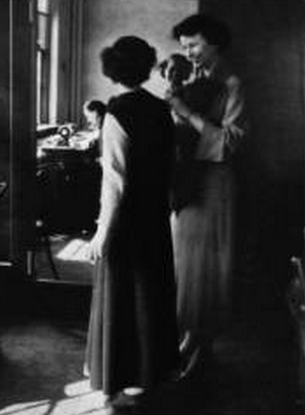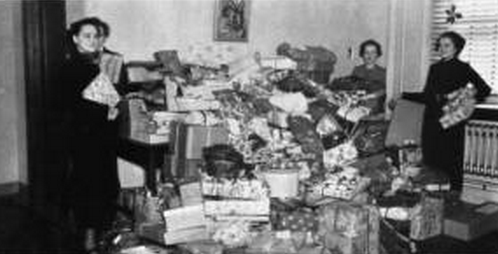It’s 1936 and H. Bentley Glass is on the science faculty at
Stephens.
 |
| H. Bentley Glass |
For those who don’t know, Glass would go on to be a well-known scientist
who was also known for his outspoken criticism of nuclear radiation and advocacy of
civil rights. He would go on to Johns Hopkins University and then the State
University of New York. The New York Times, reporting on his death in 2005,
praised him for having carved out “a reputation as one of the nation’s top
geneticists.”
But this is decades before his famous theories or work writing
biology textbooks. This year, the Stephensophia yearbook simply describes him
as being an authority on fruit flies. (You can read more about his career—and
his time at Stephens—here).
 |
| Albert Christ-Janer |
Glass isn’t the only faculty member at Stephens this year
who would go on to fame in their respective fields. In the art department,
Albert Christ-Janer is described as one of the “justly f
In theatre, we’re told a summer theatre program has begun
(today, the Summer Theatre Institute and Okoboji Summer Theatre are hallmarks
of the Theatre program). Frank McMullan was one of the faculty organizers.
McMullan went on to join the Yale drama faculty and eventually became head of
the directing department. His lecture notes, production files and manuscripts
are part of the Yale University Library archives today.
And John Crighton is new to the Social Studies faculty this
year. Crighton, of course, would go down in Stephens history by recording it. He wrote" Stephens: A Story of Educational Innovation" in
1970, a book that has become really an authoritative source for all things
Stephens.
The 1936 Stephensophia is dedicated to “my wrist watch”
with staff declaring that it has “been the metronome of college joys and sorrows, ticking
slowly, solemnly in long afternoon classes…”
This year the campus saw the largest number of students,
prompting President James Madison Wood to reaffirm Stephens’ commitment to
individualized attention. In his message, he declares that no matter how many
students come to Stephens, every student will have “full claim to the services
of the faculty in meeting her individual needs.”
He writes: “Mary Smith will continue to be Mary
Smith and not just another junior or senior. To adopt any other policy would be
to violate the fundamental principle upon which the educational program of the
College rests.”
Stephens this year is represented in 42 states by 13
secretaries of admission—all men.
The administrative council—a student organization that is a
sort of Supreme Court on campus—is trying out a new theory this year, we’re
told. Rather than focusing its attention on punishment of girls who break the
rules, the yearbook says the council is looking for the “causes prompting their
misconduct.” The council wants to give purpose to her schooling and “diminish
her desire to go against the grain.” Members conclude that few girls
intentionally break rules, so they simply need to foster better understanding
to eliminate misconduct.
The Senior Class this year is emphasizing the Honor Code, as
well (makes you wonder what sorts of mischief our 1936 alumnae were up to).
The class assures readers that the code “does not employ spies” (whew) nor are fellow
students going to report bad behavior to college officials. Instead, the Honor
Code means doing the right thing for one’s own satisfaction and out of loyalty
to classmates.
 |
| Designing a garment. |
The Junior Class uses its page to focus on praising the
advisory system at Stephens, which we’re told is “perfected here to a degree not
often reached by other schools.” Advisers aren’t just helping students navigate
coursework, they also help her through social and personal issues. “The
Stephens tradition of personal interest in its students could hardly be
maintained with the enlarged enrollment except for its smoothly working
advisory system,” the yearbook says.
There’s a new personal grooming department at Stephens this
year, which aims to improve the appearance of a Stephens girl. As outdated as
this might seem, it includes fashion design, which is, of course, an extremely popular
program at Stephens and viable career today.
Stephens students this year “adopted” orphans in a
neighboring institution at Christmastime and brought them toys and “doo-dads.”
In addition to warm clothes and other necessities, the yearbook tells us that
gift baskets for families also included some less essential gifts.
 |
| Collecting gifts at Christmastime |
Rhythm is still embedded in athletics but has begun offering
tap and social dancing classes—the precursor, of course, to our dance program.
Stephens clubs also hosted some well-known guests this year.
The Book Club brought in Upton Close, who was at this time an author and radio
commentator (he became a more polarizing commentator in the 1940s), and James
Middleton Murry, a prolific writer who, for a short time, started and ran a
magazine with D. H. Lawrence. The athletics club this year also brought Mary K.
Browne, the first American female professional tennis player, to campus.

No comments:
Post a Comment